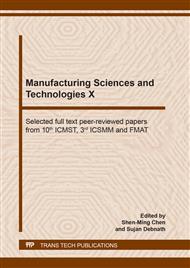[1]
Amuthakkannan, P., Manikardan, V., Jappes, J. T. W., and Uthayakumar, M.,. Effects of fiber length and fiber content on mechanical properties of short basalt fiber reinforced polymer matrix composites. Materials Physics & Mechanics 16, pp.107-117. (2013).
DOI: 10.1515/secm-2012-0144
Google Scholar
[2]
Boonlertamut, J., Wongpajan, R., Thumsorn, S., and Hamada, H.,. Characterization of polypropylene/bamboo fiber composites modified with polyethylene grafted maleic anhydride. Kyoto Institute of Technology, Japan. 338-341, (2016).
Google Scholar
[3]
John, M. J. and Anandjiwala, R. D.,. Recent Developments in Chemical Modification and Characterization of Natural Fiber Reinforced Composites. Polymer Composites 29 (2), 187-207, (2008).
DOI: 10.1002/pc.20461
Google Scholar
[4]
Okubo, K., Fujii, T., and Yamamoto, Y.,. Development of bamboo-based polymer composites and their mechanical properties. Composites: Part A, 35:377-383, (2004).
DOI: 10.1016/j.compositesa.2003.09.017
Google Scholar
[5]
Yendhe, V.S., Landge, N.B., Thorat M.B. Development and Investigation of Mechanical Behavior of Bamboo Based Fiber Composites. International Journal for Research in Applied Science & Engineering Technology (IJRASET), 3(6), 296-301, (2015).
Google Scholar
[6]
Phuong, N. T., Sollogoub, C., and Guinault, A. Relationship between fiber chemical treatment and properties of recycled PP/bamboo fiber composites. Journal of Reinforced Plastics and Composites 29 (21), 3244-3256, (2010).
DOI: 10.1177/0731684410370905
Google Scholar
[7]
Mohanty, A. K., Misra, M., Drzal, L. T., Selke, S. E., Harte, B. R., and Hinrichsen, G.,. Natural Fiber, Biopolymers and Biocomposites. 896 p., ISBN 9780849317415, CRC Press Inc., USA, (2005).
DOI: 10.1201/9780203508206.ch1
Google Scholar
[8]
Joseph, S., Sreekala, M. S., Ommen, Z., Kosy, P. K., Thomas, S.,. A comparison of mechanical properties of phenol formaldehyde composite reinforced with banana fibers and glass fibers. Composites Science and Technology, 1857-1868, (2002).
DOI: 10.1016/s0266-3538(02)00098-2
Google Scholar
[9]
Matzinos, P., Tserki, V., and Panayiotou, C. Novel biodegradable composites based on treated lignocellulosic waste flour as filler. Composites Part A, pp.1231-1238, (2006).
DOI: 10.1016/j.compositesa.2005.09.004
Google Scholar
[10]
Mohebby, B., Younesi, H., Ghotbifar, A., and Kazemi, S. Water and moisture and thickness swelling in polypropylene/wood flour/glass fibre hybrid composites. Journal od Reinforced, Plastics, and Composites, Vol. 29, 830-839, (2009).
DOI: 10.1177/0731684408100702
Google Scholar
[11]
Shakeri, A., and Ghasemian, A.,. Water absorption and thickness swelling of polypropylene reinforced with hybrid recycled newspaper and glass fiber. Appl Compos Mat (2010) 17: 183-193, (2009).
DOI: 10.1007/s10443-009-9111-9
Google Scholar


